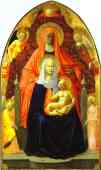Masolino da Panicale Biography
His major works can be found in Florence, Lombardy, Umbria, and Rome. Masolino da Panicale was a pupil of Ghilberrti. There is a belief that Masolino was Masaccio’s teacher. Whether it's true or not, both painters worked successfully in 1424, when the Virgin and Child with St. Anne (St. Anne Meterza) marked the start of their partnership, which culminated in the Brancacci Chapel in St. Maria del Carmine in Florence. In 1425, Masolino left for Hungary in the train of Cardinal Branda Castiglione. Later, in 1428, the Cardinal invited him to Rome to paint the frescoes in the private chapel of the church of St. Clement’s. The frescos were dedicated to the Scenes from the Life of St. Catherine of Alexandria. Cardinal Castiglione summoned him again in 1435, this time to Castiglione Olona in Lombardy. Together with other major Tuscan artists he painted the frescos in the Collegiate choir, some of the rooms in the Cardinal’s palace and, most importantly, a spectacular section of the Baptistry.
Masolino’s method of depicting figures remained that of the late-Gothic, but at the same his objects have volume and give a sense of perspective to the spectators, which means that he must be considered one of the heralds of Renaissance art.
Bibliography
Painting of Europe. XIII-XX centuries. Encyclopedic Dictionary. Moscow. Iskusstvo. 1999.
The Art of the Italian Renaissance. Architecture. Sculpture. Painting. Drawing. Könemann. 1995.
The Panel Paintings of Masolino and Masaccio: The Role of Technique by Carl B Strehlke, Cecilia Frosinini. 5 Continents Editions, 2002.
Masaccio & Masolino by Paul Joannides. Phaidon Press, 1994.
- St. Anne Meterza.

1424. Tempera on panel. Galleria degli Uffizi, Florence, Italy. Read Note.